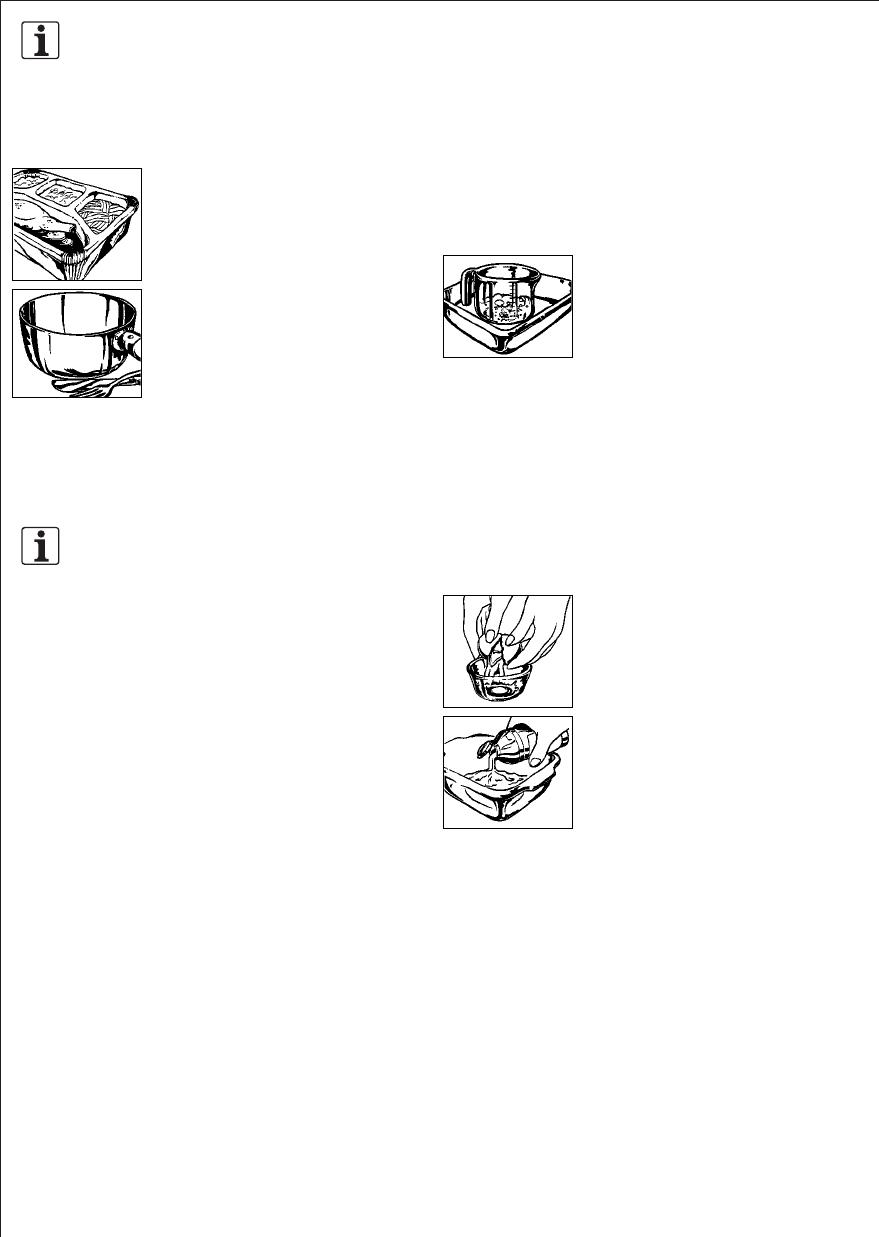
8
Suitable ovenware
Metal
Generally speaking, metal should not be used, since
microwaves do not pass through metal and therefore
cannot reach the food. There are,
however, exceptions: small strips of
aluminium foil may be used to
cover certain parts of the food, so
that these do not thaw too quickly
or begin to cook (e.g. chicken
wings). Small metal skewers and
aluminium containers (e.g. of
ready- cooked meals) can be used.
They must, however, be small in
relation to the food, e.g. aluminium
containers must be at least 2/3 to 3/4 filled with food.
It is recommended that you transfer the food into a
dish suitable for use in the microwave.
When using aluminium containers or other metal
utensils there must be a gap of approx. 2 cms between
them and the walls of the cooking area, otherwise the
walls could be damaged by possible arcing.
No utensil should have a metal overlay metal parts
such as screws, bands or handles.
UTENSIL SUITABILITY TEST
If you are not sure whether your
utensil is suitable for use in your
microwave oven, carry out the
following test: Place the utensil
into the oven. Place a glass
container filled with 150 ml of water on or next to the
utensil. Switch on the oven at 900 W power for 1 to 2
minutes. If the utensil stays cool or just warm to the
touch, it is suitable. Do not use this test on a plastic
utensil. It could melt.
Do not cook eggs in their unbroken
shells. Pressure builds up inside the
shell and this may result in the egg
exploding. Prick the yolk before you
cook it.
Do not heat oil or fat for deep-
frying inside the microwave oven. It
is impossible to control the
temperature of the oil and it may
suddenly splash out of the pan.
Do not heat sealed containers such
as jars or tins. The pressure inside the container could
cause the container to explode. (The exception is when
you are making preserves).
All indicated cooking times...
are guidelines only. Cooking times may vary depending
on starting temperature, the weight and composition
(water, fat content, etc) of the food.
Salt, herbs and spices
Food cooked in the microwave oven retains its taste
better than with conventional cooking methods. Use
salt sparingly and as a rule only add salt after the food
has cooked. Salt binds liquids and dries out the surface
of food. Herbs and spices can be used as normal.
Tips & advice
Before you start...
To make it as easy as possible to use the microwave
oven, we have put together a few hints and tips for you.
Only switch on the oven when the food is already inside.
Setting the cooking time
Defrosting, re-heating and cooking times are generally
much shorter than in a conventional oven or hob. So
you will need to consult this book for the
recommended cooking times. It is better to set shorter
rather than longer cooking times. Always test the food
after the cooking time has elapsed. It is better to then
continue cooking it for a little longer, than to have
overcooked food.
Starting temperature
Defrosting, re-heating and cooking times depend on
the temperature of the food when you start. For
example, deep-frozen and refrigerated food will need
longer than food that is at room temperature.
Standard storage temperatures of food are assumed for
re-heating and cooking times (refrigerator temperature
of 5° C, room temperature of approximately 20° C). For
defrosting food a starting temperature of
approximately -18° C is assumed.
Cook popcorn only in special microwave safe
containers. Refer exactly to the manufacturer’s
instructions. Do not use a normal paper or glass
container.
2. AG-32D-UK ENGLISH 20/05/2004 12:01 Page 8


















